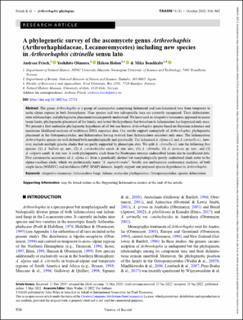| dc.description.abstract | The genus Arthrorhaphis is a group of ascomycetes comprising lichenised and non-lichenised taxa from temperate to arctic-alpine regions in both hemispheres. Nine species and two infraspecific taxa are currently recognised. Their delimitation, inter-relationships, and phylogenetic placement remain poorly understood. We have used an integrative taxonomic approach to assess taxon limits, phylogenetic placement of the family, and to test the hypothesis that transition to lichenisation has happened only once. We present a first molecular phylogenetic hypothesis of all but one known Arthrorhaphis species based on Bayesian inference and maximum likelihood analyses of multilocus DNA sequence data. Our results support monophyly of Arthrorhaphis, phylogenetic placement in the Ostropomycetidae, and lichenisation having evolved from lichenicolous ancestors only once. The lichenicolous Arthrorhaphis species are well-defined both morphologically and genetically. The lichenised A. alpina s.l. and A. citrinella s.l., however, include multiple genetic clades that are partly supported by phenotypic data. We split A. citrinella s.l. into the following five species: (1) A. bullata sp. nov., (2) A. catolechioides comb. & stat. nov., (3) A. citrinella, (4) A. farinosa sp. nov., and (5) A. vulgaris comb. & stat. nov. A sixth phylogenetic clade from the Neotropics remains undescribed herein due to insufficient data. Five circumarctic accessions of A. alpina s.l. form a genetically distinct but morphologically poorly understood clade sister to the alpina-vacillans clade, which we preliminarily name “A. septentrionalis”. Jointly, our multispecies coalescence analyses, of both single-locus (bGMYC) and multilocus (bPtP, bP&P) datasets, largely support our proposed species hypotheses in Arthrorhaphis. | en_US |

